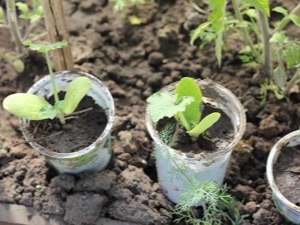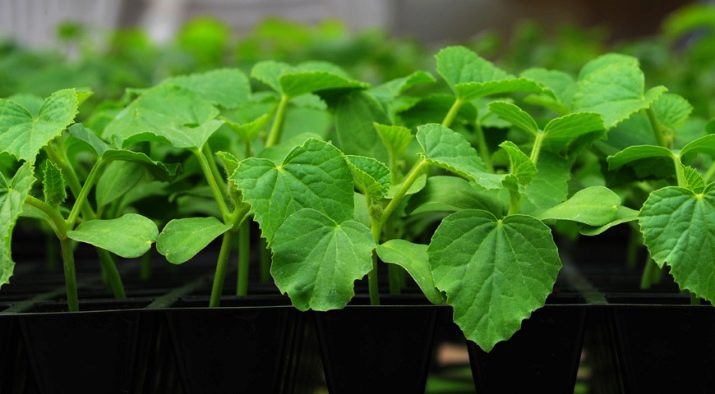How to distinguish the seedlings of squash from seedlings of cucumbers?

Planting material for cucumbers and zucchini is easy to confuse, especially if the owner of the backyard plot does not have some experience in growing these crops.Small, barely opened leaves of both plants are practically indistinguishable, especially if shoots appeared quite recently. It should understand in detail what the seedlings of both vegetables look like.
The main differences
Zucchini is brought to us from Mexico, it is just like a cucumber, belongs to the Pumpkin family and is a subspecies of this vegetable. Gardeners love this crop for its unpretentiousness, resistance to cold, besides, the plant rarely gets sick and in most cases gives a bountiful harvest.
Care is also not particularly difficult, so even inexperienced owners can grow squash. In the ordinary market, unfortunately, seed mixing can happen and it is necessary to know the differences between squash seedlings and cucumbers. To do this, consider the main characteristics of the cotyledon leaflets sprouts, such as:
- their size;
- shape feature;
- sheet thickness.
If you take the appearance of plants for comparison, you can see the following:
- the cotyledon zucchini leaves are more rounded with a slightly pointed tip, while the cucumbers are elongated and oblong, and their end is rounded; if to describe the form, then most of all they resemble an ellipse;
- in size, squash seedlings are noticeably larger and are distinguished by a thicker stem and leaf thickness than a cucumber;
- the surface of the zucchini leaves, which has characteristic folds that his opponent does not have, is markedly different.
Another way to distinguish between plants is to compare the smell of the leaves of that and another vegetable. It is enough to rub the squash and cucumber leaves in their hands.
In the zucchini, it has an incomparable, specific aroma, while cucumber seedlings, in general, do not smell. As you can see, the definition of a plant species is difficult only in the phase of cotyledonary leaves - it is at this point that vegetable shoots will have to be carefully considered. In the future, it will be easy to understand who is who, because after the appearance of these leaves, a cucumber stops its development. Squash, on the contrary, pleases with rapid growth, and then you can see its characteristic, large fringed leaves.
Useful tips
In the southern districts, squash is planted in open soil, but for colder climatic zones it is better to use seedlings. In order not to confuse it with the seeds of pumpkin, cucumber and other crops, experts in this area recommend adhering to a few tips.
- To acquire material for planting squash, and for other plants, it is necessary in special seed-growing nurseries, which are engaged in selection and maintain the optimal properties of various sown plants. The main advantage of such farms is the cleanliness of seedlings that meet the relevant standards.
- If the owner has already grown these crops and harvested, after drying the seeds, they should be placed in separate paper bags and labeled with the name and date of harvest. This will allow in the future no doubt that can grow on the site.
In general, both crops require the same growing conditions - the selection, processing and sowing of seeds occurs using similar technologies, vegetables do not like in the vicinity of plants with high stems and massive foliage, shielding them the sun, as well as frost, cold, so they are planted in the ground only in the warm season.
Even the soil and fertilizer during the growing season they need the same, so many fans plant these plants next to each other. There are two diametrically opposite opinions on this issue. Some gardeners consider this a mistake - due to the fact that they have the same inflorescences, in the immediate vicinity these crops can be incorrectly pollinated due to an excess of pollen obtained by female flowers. As a result, you can encounter a bad ovary, which will affect the amount of the crop in a negative way.
There are other obstacles that hinder the growth of crops in the neighborhood, namely:
- squash shoots in the form of antennae, preventing the active growth of cucumbers;
- rapid depletion of soil due to the needs of plants in the same minerals and trace elements;
- intertwining powerful roots zucchini thinner root system of cucumbers.
Other owners of their own farm express their opinion that cucumber and squash crops do not have allopathic influence on each other, so they can be planted side by side even in a small area, if you use a linear arrangement during planting. And you also have to ensure that the green mass of the zucchini does not drown out the leaves of the cucumber.
If it was not possible to distinguish the plants on the phase of the cotyledon leaves in time, and they were planted alternately in the ground, you can advise to leave everything as is - even in this case, you can get quite a decent crop, but you should not collect the seeds of these plants for seedlings, and next year better to buy a new planting material.
You can learn more about how to distinguish cucumber seedlings from squash, in the next video.




























